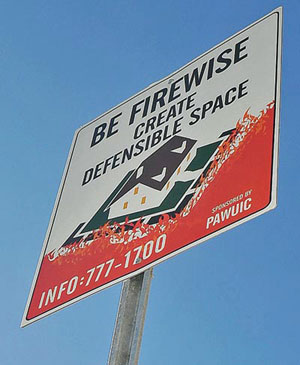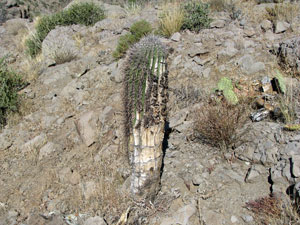BY MARGARET STEWART | JULY 27, 2011
 Fire: the Good,
Fire: the Good,
the Bad and the Necessary
Use defensible space to protect your home
 New signs designed to build awareness of the need to create defensible space around homes to protect against wildfires.
New signs designed to build awareness of the need to create defensible space around homes to protect against wildfires.
Courtesy photo by Matt Hinshaw/The (Prescott) Daily Courier
At the November 2003 Desert Awareness evening lecture, co-sponsored by the Town of Cave Creek Recreation Department, information was presented on the role of fire in desert ecosystems and the importance of defendable space in the wild land/urban interface. The following article is based on the remarks made that evening by Andy Mandell from the Cave Creek Ranger District of the Tonto National Forest and Assistant Chief Jim Ford from Rural/Metro.
Fire is now recognized as an important management tool. The 2.9 million acres of the Tonto National Forest receive the second highest number of lightning strikes in the United States. The change of topography associated with the 2000-foot escarpment of the Mogollon Rim contributes to this abundance of lightning. If lightning fires begin in wilderness areas of the Tonto forest, the policy is to let these natural fires burn when they are remote and isolated. These are the “good” fires that are part of the rejuvenation cycle in natural ecosystems.
The “bad” fires are largely the result of human interference in natural processes. One hundred years of fire suppression in our forests allowed the accumulation of dead and down fuels. In logged areas, overstocking by planting too many trees too close together created artificially dense forests. Natural tree regeneration, without the thinning effect of fire and overgrazing that would have reduced competing under-story vegetation, also contributed to overly dense forests. When too many trees compete for limited resources of water, nutrients and sunlight, individual trees do not have enough sap to pitch out burrowing bark beetles. Bark beetles carry a fungus that kills conifers. The result is too much fuel in thousands of acres of dense forest with dead or dying trees.
This is a prescription for high intensity, catastrophic crown fires that are almost impossible to stop without the help of “Mother Nature” in the form of high relative humidity, precipitation and reduced wind speeds.
The Forest Service is reducing this hazardous situation by using fire to fight fire. Prescribed burns (“good” fires) are an effective tool to restore forest health. The goal is to burn 20,000 to 30,000 acres per year using small, controlled fires that are only ignited when conditions fit within narrow burn parameters. Relative humidity must be high, wind speeds low, and fuel moisture content (the amount of water in calibrated blocks of wood) at levels that allow the fire to be controlled. The goal is a cool fire that reduces the down and dead material on the forest floor, eliminates patches of dense forest and kills the understory of small trees that form ladders allowing hot fires to reach the canopy of taller trees.
One prescribed burn in an area is not the answer to the problems in our forests. Fire must become a tool that is used repeatedly to maintain forest health and restore diversity in forest watersheds. After a fire, plant species that were absent from the overstocked forest reappear from dormant seed stored in the soil seed bank. Wildlife can move away from prescribed burns and quickly return to rejuvenating forests. The public needs information on the scheduling of prescribed burns so that individuals who are sensitive to smoke can take precautions, but we all need to understand that a healthy forest is one where fire is a natural part of ecosystem management.
However, fire has the potential to be very “bad” when it enters the wild land/urban interface. This summer’s fires on Mount Lemmon and in Southern California illustrate just how bad fire can be. Rural/Metro and the Tonto National Forest work together when fire threatens the Desert Foothills communities. Personnel from both groups are available to respond as needed.
As homes grow out into what were formerly uninhabited natural areas, precautions need to be taken to reduce the fire hazard. In an emergency situation firefighters must evaluate which homes can be saved and which ones cannot be protected. Roofing material can be a significant factor in affecting the ability of firefighters to save a home. Tile and metal roofs offer more fire protection than flat built-up roofs or composition shingles. Wood shingle roofs are extremely flammable.
In the last few years wildfires in the Desert Foothills have been confined to less than four acres with the fire being brought under control in less than an hour. But in late July 1995, things were different when a lightning strike near Dynamite Road started a fire that burned 2,000 acres. The Rio Fire, as it was called, burned for days, but no houses were lost. The strategy was to allocate resources to save homes and let areas in-between burn. Assistant Chief Ford’s video of air tankers dropping fire retardant on the desert just south of Carefree is very dramatic, as are the comments of residents whose homes and businesses were saved through the efforts of firefighters.
Saving homes is easier if there is a 30-foot defendable area around the house. This does not mean that the 30-foot buffer should be stripped bare of vegetation. Rather, lower branches of trees should be trimmed above the height of surrounding bushes and areas of continuous fuels should be reduced by creating breaks between individual bushes and trees.
 During Assistant Chief Ford’s years with Rural/Metro, the only house lost to a wildfire was a home in Paradise Valley where the vegetation grew up underneath and was touching a wooden deck extending out over the hillside. With no defendable area around the house and a fire burning uphill, Rural/Metro was severely handicapped in its attempt to save the residence. If you are concerned about the adequacy of your home’s 30-foot defendable area, Rural/Metro will come out and provide a free inspection of your property and offer advice as to how to reduce the chance of a “bad” fire targeting your home.
During Assistant Chief Ford’s years with Rural/Metro, the only house lost to a wildfire was a home in Paradise Valley where the vegetation grew up underneath and was touching a wooden deck extending out over the hillside. With no defendable area around the house and a fire burning uphill, Rural/Metro was severely handicapped in its attempt to save the residence. If you are concerned about the adequacy of your home’s 30-foot defendable area, Rural/Metro will come out and provide a free inspection of your property and offer advice as to how to reduce the chance of a “bad” fire targeting your home.




 PHOENIX – The Wal-Mart Foundation has awarded grant funding in the amount of $25,000 to Goodwill of Central Arizona to assist with direct costs of implementing career center services at 12 locations throughout Maricopa County and Yuma.
PHOENIX – The Wal-Mart Foundation has awarded grant funding in the amount of $25,000 to Goodwill of Central Arizona to assist with direct costs of implementing career center services at 12 locations throughout Maricopa County and Yuma. People wanting to get active, learn a new skill and have fun this fall can now view the Phoenix Parks and Recreation Departments full spring class and program schedule online. Fall session classes run roughly from September through November and boast affordable prices, experienced instructors and convenient times and locations. Participants can view the full schedule in the Classes and Programs link at
People wanting to get active, learn a new skill and have fun this fall can now view the Phoenix Parks and Recreation Departments full spring class and program schedule online. Fall session classes run roughly from September through November and boast affordable prices, experienced instructors and convenient times and locations. Participants can view the full schedule in the Classes and Programs link at